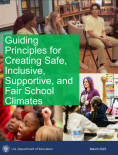Developmentally appropriate practice (DAP) recognizes that decisions made about materials, interactions, curriculum, and instruction affect how children learn and develop. Developmentally appropriate practice meets children “where they are” with respect to age, ability, and culture and builds their ability to participate and be engaged in the classroom environment. Developmentally appropriate practice entails planning and delivering educational content and supports that cut across all domains of development, whether cognitive skills, executive function, social-emotional skills, or problem-solving skills. Within these domains, not only should support focus on developmentally ready children, but ready families, schools, and communities. Developmentally appropriate practice includes the use of positive discipline approaches, respecting and responding to cultural and linguistic diversity, and offering appropriate accommodations when necessary.
Working together as partners, families, schools, and communities can create and improve opportunities for children to develop social, emotional, and academic competencies. Partnership entails reciprocal relationships in which schools make efforts to support and strengthen families, families engage in their child’s education, and communities offer resources and supports that will enhance children’s development and learning.
Research has demonstrated the value of protective factors in facilitating children’s well-being. These include resilience, concrete support in times of need, social and emotional competence, and positive school connectedness. Risk factors, such as exposure to violence, parental mental health issues, and negative attitudes toward school, can increase the chances a child will experience social-emotional, behavioral, or academic issues. In addition to promoting children’s learning and development, protective factors can serve as a cushion or buffer against these types of challenges.
Howes, C., Bryant, D., Burchinal, M., Clifford, R., Early, D., Pianta, R., Ritchie, S. (2006). National Center for Early Development and Learning (NCEDL) issued statement. Chapel Hill, NC: NCEDL, FPG Child Development Institute.
Maxwell, K. L., Ritchie, S., Bredekamp, S., & Zimmerman, T. (2009). Issues in PreK-3rd education: Using developmental science to transform children’s early school experiences (#4). Chapel Hill: The University of North Carolina, FPG Child Development Institute, FirstSchool.
Sanders, K., & Farago, F. (2018). Developmentally Appropriate Practice in the Twenty-First Century. In M. Fleer & B. van Oers (Eds.), International Handbook of Early Childhood Education (pp. 1379-1400). Dordrecht: Springer Netherlands.









